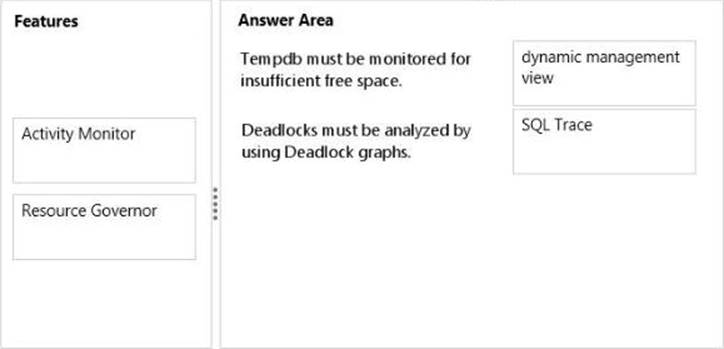- All Exams Instant Download
Which features should you identify?
DRAG DROP
You plan to deploy SQL Server 2014. Your company identifies the following monitoring requirements:
Tempdb must be monitored for insufficient free space.
Deadlocks must be analyzed by using Deadlock graphs.
You need to identify which feature meets each monitoring requirement.
Which features should you identify? To answer, drag the appropriate feature to the correct monitoring requirement in the answer area.

Answer: 
Explanation:
You can use the sys.dm_db_file_space_usage dynamic management view to monitor the disk space used by the user objects, internal objects, and version stores in the tempdb files. Additionally, to monitor the page allocation or deallocation activity in tempdb at the session or task level, you can use the sys.dm_db_session_space_usage and sys.dm_db_task_space_usage dynamic management views.
These views can be used to identify large queries, temporary tables, or table variables that are using a large amount of tempdb disk space.
Use SQL Server Profiler to identify the cause of a deadlock. A deadlock occurs when there is a cyclic dependency between two or more threads, or processes, for some set of resources within SQL Server.
Using SQL Server Profiler, you can create a trace that records, replays, and displays deadlock events for analysis.
SQL Server Profiler and SQL Server Management Studio use a deadlock wait-for graph to describe a deadlock. The deadlock wait-for graph contains process nodes, resource nodes, and edges representing the relationships between the processes and the resources. References: Troubleshooting Insufficient Disk
Space in tempdb
References: Analyze Deadlocks with SQL Server Profiler
Latest 70-764 Dumps Valid Version with 451 Q&As
Latest And Valid Q&A | Instant Download | Once Fail, Full Refund
Subscribe
Login
0 Comments
Inline Feedbacks
View all comments

